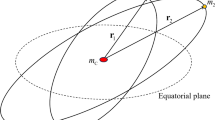Abstract
The source position time-series for many of the frequently observed radio sources in the NASA geodetic very long baseline interferometry (VLBI) program show systematic linear and non-linear variations of as much as 0.5 mas (milli-arc-seconds) to 1.0 mas, due mainly to source structure changes. In standard terrestrial reference frame (TRF) geodetic solutions, it is a common practice to only estimate a global source position for each source over the entire history of VLBI observing sessions. If apparent source position variations are not modeled, they produce corresponding systematic variations in estimated Earth orientation parameters (EOPs) at the level of 0.02–0.04 mas in nutation and 0.01–0.02 mas in polar motion. We examine the stability of position time-series of the 107 radio sources in the current NASA geodetic source catalog since these sources have relatively dense observing histories from which it is possible to detect systematic variations. We consider different strategies for handling source instabilities where we (1) estimate the positions of unstable sources for each session they are observed, or (2) estimate spline parameters or rate parameters for sources chosen to fit the specific variation seen in the position-time series. We found that some strategies improve VLBI EOP accuracy by reducing the biases and weighted root mean square differences between measurements from independent VLBI networks operating simultaneously. We discuss the problem of identifying frequently observed unstable sources and how to identify new sources to replace these unstable sources in the NASA VLBI geodetic source catalog.
Similar content being viewed by others
References
Charlot P (1990) Radio-source structure in astrometric and geodetic very long baseline interferometry. Astron J 116:1309–1326
Charlot P (2002) Modeling radio source structure for improved VLBI data analysis. In: Vandenberg NR, Baver KD, (eds) International VLBI service for geodesy and astrometry 2002 general meeting proceedings, NASA/CP-2002-210002, pp 233–242
Dehant V, Feissel-Vernier M, de Viron O, Ma C, Yseboot M, Bizouard C (2003) Remaining error sources in the nutation at the submilliarc second level. J Geophys Res 108(B5):2275–2286., DOI10.1029/2002JB001763
Fey AL, Eubanks TM, Kingham KA (1997) The proper motion of 4C39.25. Astron J 114(6):2284–2291
Fey AL, Charlot P (1997) VLBA observations of radio reference frame sources. II. Astrometric suitability based on observed structure. Astron J Suppl Ser 111:95–142
Fey AL, Charlot P (2000) VLBA Observations of radio reference frame sources. III. Astrometric suitability of an additional 225 sources. Astron J Suppl Ser 128:17–83
Feissel-Vernier M (2003) Selecting stable extragalactic compact radio sources from the permanent astrogeodetic VLBI program. Astron Astrophys 403:105–110
Feissel-Vernier M, Ma C, Gontier A-M, Barache C (2005) Sidereal orientation of the Earth and stability of the VLBI celestial reference frame. Astron Astrophys 438:1141–1148
Johnston KJ et al (1995) A radio reference frame. Astron J 110:880–915
Ma C, Sauber JM, Bell LJ, Clark TA, Gordon D, Himwich WE, Ryan JW (1990) Measurement of horizontal motions in Alaska using very long baseline interferometry. J Geophys Res 95(B13):21991–22011
Ma C, Arias EF, Eubanks TM, Fey AL, Gontier A-M, Jacobs CS, Sovers OJ, Archinal BA, Charlot P (1998) The international celestial reference frame as realized by very long baseline interferometry. Astron J 116:516–546
MacMillan DS, Ma C (2000) Improvement of VLBI EOP accuracy and precision. In: Vandenberg NR, Baver KD, (eds) International VLBI service for geodesy and astrometry 2000 general meeting proceedings, NASA/CP-2000-209893, pp 247–251
Sovers OJ, Charlot P, Fey AL, Gordon D (2002) Structure corrections in modeling VLBI delays for RDV data. In: Vandenberg NR, Baver KD (eds) International VLBI service for geodesy and astrometry 2002 general meeting proceedings, NASA/ CP-2002-210002, pp 243–247
Author information
Authors and Affiliations
Corresponding author
Rights and permissions
About this article
Cite this article
MacMillan, D.S., Ma, C. Radio source instability in VLBI analysis. J Geod 81, 443–453 (2007). https://doi.org/10.1007/s00190-007-0136-2
Received:
Accepted:
Published:
Issue Date:
DOI: https://doi.org/10.1007/s00190-007-0136-2




